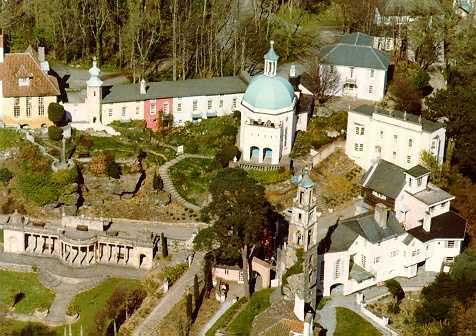Portmeirion, North Wales

On a recent holiday to North Wales I was lucky enough to spend a couple of days at
Portmeirion Village – for those of you who don’t know it, or haven’t been, it’s one
man’s architectural extravaganza over his life time (Clough Williams-Ellis), built
in predominately classical Italian style, with the aim of “bringing back some elegance
into these arid times”.
As well as building new, colourful and varied buildings, Williams-Ellis wanted his
village to be a “home for fallen buildings”, and quite a number of architectural
fancies were brought stone by stone from across Britain, revived from their dying
in their original location, to take on a cherished new life in Portmeirion. A Bristol
bath house collonade, and a “gloriette” – the mock façade of a manor – are just two
examples.
You can see some of the extravagance and charm of it here:
http://www.virtualportmeirion.com/index.htm
Whatever you think of the style, or the hotch-potch of styles (for instance the Gloriette
was placed at one end of the piazza “in vivacious contradiction” to the original
cottage in the square, “Mermaid”), Williams-Ellis has managed to achieve something
very impressive, startling even, and, in part with the aid of the enclosing topography,
a unity of purpose and cohesion, yet with much uniqueness and accent.
While aiming to provide dwellings of purpose, Williams-Ellis had just as strong a
wish to bring alive a quality he felt to be woefully ignored in modern building and
culture generally – a grace and elegance that lift the heart and make people feel
bright and alive in their surroundings. What he most wanted to bring to expression
in his work was beauty, “that strange necessity” as he called it. And so, as well
as the more obvious tokens of beautification – the statury, the spire and dome (built
after some years to complement the spire, as Williams-Ellis thought the village was
suffering from “dome-deficiency”!), the shapes and colours, the signs and murals
- we see in the design a great care in proportions and in choice of features or shapes
to give a certain effect. And to crown it all, Williams-Ellis was a great exponent
of the folly for effect; from nearly useless literal follies (the gloriette and collonade),
to mock windows painted on buildings to finish off the grace. And quite often some
quirky humour creeps in, with, for instance, the hint of a man trying to escape out
of one of the mock painted windows!
Another feature worth noting is how the buildings, even in their lavishness, appear
to grow out of the natural rockscape of the hill – he wanted the naturalness of the
land to shape, even dictate, what he built; in some places we see the rock jut into
his work, bursting through the architecture in its primitive grandeur (for instance
in the entrance arch). A wonderful example, more usual to Eastern architecture,
of the appreciation of nature.
Finally, Williams-Ellis was very keen on the idea that good design need not be costly;
for the same sum, you could build a quite dull village, or instead, with careful
thought and design, effect a beautiful work of art, at the same cost.
BM







